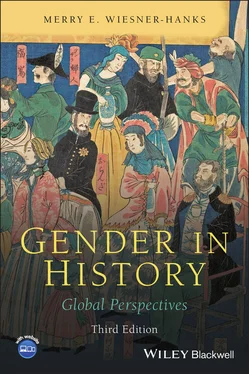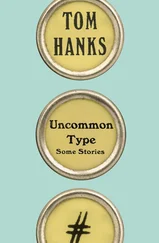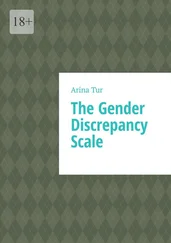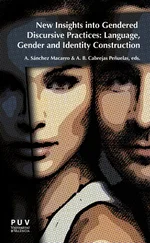Studies of the social construction of beauty and its links to gender include Sander Gilman, Making the Body Beautiful: A Cultural History of Aesthetic Surgery (Princeton, NJ: Princeton University Press, 1999); Susan R. Bordo, Unbearable Weight: Feminism, Western Culture, and the Body (2nd edn., Berkeley, CA: University of California Press, 2004).
For discussions of motherhood and fatherhood, see Clarissa W. Alkinson, The Oldest Vocation: Christian Motherhood in the Middle Ages (Ithaca, NY: Cornell University Press, 1991); Ann Taylor Allen, Feminism and Motherhood in Germany, 1800–1914 (New Brunswick, NJ: Rutgers University Press, 1991); Rima D. Apple and Janet Golden, eds., Mothers and Motherhood: Readings in American History (Columbus, OH: Ohio State University Press, 1997); Ralph LaRossa, The Modernization of Fatherhood: A Social and Political History (Chicago, IL: University of Chicago Press, 1997); Heléna Ragoné and France Winddance Twine, eds., Ideologies and Technologies of Motherhood: Race, Class, Sexuality, and Nationalism (New York: Routledge, 2000); Marguerite Guzman Bouvard, Revolutionizing Motherhood: The Mothers of the Plaza de Mayo (New York: SR Books, 2002); Lynn Trev Broughton and Helen Rogers, eds., Gender and Fatherhood in the Nineteenth Century (New York: Palgrave Macmillan, 2007); Marian van der Klein et al., eds., Maternalism Reconsidered: Motherhood, Welfare and Policy in the Twentieth Century (London: Berghahn, 2012); Rhiannon Stephens, A History of African Motherhood: The Case of Uganda, 700–1900 (Cambridge, UK: Cambridge University Press, 2013); Oyeronke Oyewumi, What Gender Is Motherhood?: Changing Yoruba Ideals of Power, Procreation, and Identity in the Age of Modernity (New York: Palgrave Macmillan, 2016); Jodi Vandenburg-Daves, Modern Motherhood: An American History (New Brunswick, NJ: Rutgers University Press, 2014); Jürgen Martschukat, American Fatherhood: A History (New York: NYU Press, 2019).
Almost every book in this list, as well as most of those suggested in the other chapters, refers to ideologies prescribing difference or inequality. Some recent overviews include Jack Holland, A Brief History of Misogyny: The World’s Oldest Prejudice (London: Robinson, 2019) and Kate Manne, Down Girl: The Logic of Misogyny (New York: Oxford University Press, 2019).
On feminism, good places to start are Estelle B. Freedman, The Essential Feminist Reader (New York: Modern Library, 2007); Lucy Delap, Feminisms: A Global History (Chicago, IL: University of Chicago Press, 2020); or Bonnie G. Smith, ed., Routledge Global History of Feminism (London: Routledge, 2021). More detailed studies include: Chilla Bulbeck, Re-orienting Western Feminisms: Women’s Diversity in a Post-colonial World (Cambridge, UK: Cambridge University Press, 1998); bell hooks, Feminism Is for Everybody: Passionate Politics (Cambridge, UK: South End Press, 2000); Patricia Hill Collins, Black Feminist Thought: Knowledge, Consciousness and the Politics of Empowerment (2nd edn., New York: Routledge, 2000); Bonnie Smith, ed., Global Feminisms since 1945: Rewriting Histories (New York: Routledge, 2000); Chandra Talpade Mohanty, Feminism without Borders: Decolonizing Theory, Practicing Solidarity (Durham, NC: Duke University Press, 2003); Valentine M. Moghadam, Globalizing Women: Transnational Feminist Networks (Baltimore, MD: Johns Hopkins University Press, 2005); Vivien Labaton and Dawn Lundy Martin, eds., The Fire This Time: Young Activists and the New Feminism (New York: Anchor Books, 2004); Joyce Green, ed., Making Space for Indigenous Feminism (New York: Zed Books, 2007); Karen Offen, ed., Globalizing Feminisms, 1789–1945 (London: Routledge, 2010); Amanda Lock Swarr and Riacha Nagar, eds., Critical Transnational Feminist Praxis (New York: SUNY Press, 2010).
For some of the newest currents in feminism, see Chimamanda Ngozi Adichie, We Should All Be Feminists (New York: Anchor Books, 2015); Amrita Basu, Women’s Movements in the Global Era: The Power of Local Feminisms (2nd edn., Boulder, CO: Westview Press, 2017); Nicola Rivers, Postfeminism(s) and the Arrival of the Fourth Wave: Turning Tides (London: Palgrave Macmillan, 2017); Lynn Fugiwara and Shireen Roshanravan, eds., Asian American Feminisms and Women of Color Politics (Seattle, WA: University of Washington Press, 2018); June Eric-Udorie, ed., Can We All Be Feminists?: New Writing from Brit Bennett, Nicole Dennis-Benn, and 15 Others on Intersectionality, Identity, and the Way Forward for Feminism (London: Penguin Books, 2018); Katherine M. Marino, Feminism for the Americas: The Making of an International Human Rights Movement (Chapel Hill, NC: The University of North Carolina Press, 2019); Daisy Hernández and Bushra Rehman, eds., Colonize This! Young Women of Color on Today’s Feminism (2nd edn., London: Seal Press, 2019).
1 1Translated and quoted in Charlotte Furth, A Flourishing Yin: Gender in China’s Medical History, 960–1665 (Berkeley, CA: University of California Press, 1999), p. 45.
2 2Mary Wollstonecraft, A Vindication of the Rights of Women (London: Penguin Books, 1982), p. 293.
3 3Nancy Ward (Nanye’hi), “Speech to the U.S. Treaty Commissioners,” in Lisa L. Moore, Joanna Brooks, and Caroline Wigginton, eds., Transatlantic Feminisms in the Age of Revolution (New York: Oxford University Press, 2012), p. 180.
Конец ознакомительного фрагмента.
Текст предоставлен ООО «ЛитРес».
Прочитайте эту книгу целиком, купив полную легальную версию на ЛитРес.
Безопасно оплатить книгу можно банковской картой Visa, MasterCard, Maestro, со счета мобильного телефона, с платежного терминала, в салоне МТС или Связной, через PayPal, WebMoney, Яндекс.Деньги, QIWI Кошелек, бонусными картами или другим удобным Вам способом.












